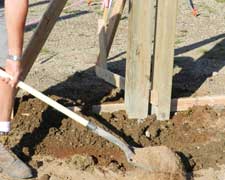 In typical pole building construction, holes are augured into the earth, columns are placed in the hole so concrete can be placed below the column to act as a footing for vertical support, as well as to encase the lower portion of the column. Above this “bottom collar” compacted soil backfill is used to fill the void between the column and the edges of the holes.
In typical pole building construction, holes are augured into the earth, columns are placed in the hole so concrete can be placed below the column to act as a footing for vertical support, as well as to encase the lower portion of the column. Above this “bottom collar” compacted soil backfill is used to fill the void between the column and the edges of the holes.
Controlled low-strength material (CLSM) is self-compacted, cementitious material primarily used as a structural fill or backfill alternative to compacted soil backfill. It is often referred to by different names including flowable fill, controlled density fill, soil-cement slurry, unshrinkable fill, plastic soil cement and flowable mortar. It is self-leveling, having the approximate consistency of pancake batter, and can be placed in one lift with minimal labor and no vibration or tamping. The American Concrete Institute (ACI) defines CLSM as having a compressive strength less than 1200 psi (pounds per square inch), however most current CLSM applications require unconfined compressive strengths of less than 300 psi. This lower strength is more than comparable with strength of compacted soil backfill.
Since CLSM is designed to be fluid, it can be easily placed as backfill in a hole. Soil backfill, even if compacted properly in the required layer thicknesses, cannot achieve the uniformity and density of CLSM.
CLSM mixtures typically consist of water, portland cement, fly ash, and fine or course aggregates, or both. Some mixtures contain only water, portland cement, and fly ash. Although the materials used in CLSM may meet ASTM or other standard specifications, it is often not necessary to use standardized materials. The selection of materials for use in CLSM is based on cost, specific CLSM application and the required mixture characteristics including flowability, strength, excavatability and density. The use of fly ash improves the CLSM flowability, and can also increase strength and reduce the mixture’s bleeding, shrinkage and permeability. Air-entraining admixtures are also often used to help improve workability, reduce bleeding, help minimize segregation, reduce the unit weight, and control strength development.
Aggregates are usually the major component in CLSM, and their type, grading and shape can affect physical properties. Unlike conventional concrete aggregate, which is usually required to meet standardized specifications, CLSM aggregate need not necessarily meet these same standards to be effective. As an example, manufactured sands containing up to 20% non-deleterious dust of fracture have proven to be very satisfactory






